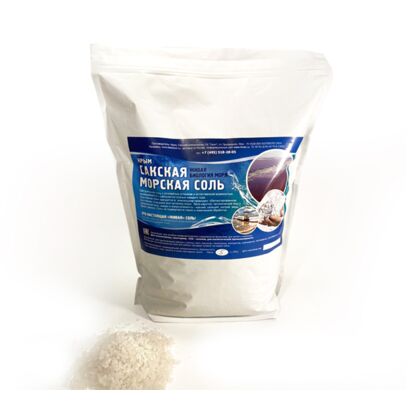Crimean sea pink bath salt
Eco-friendly Crimean pink sea salt from Saki salt lakes contains a full range of balanced macro- and microelements (magnesium, potassium, calcium, iron, manganese, bromine, boron). Mineral baths with Saki sea salt improve blood circulation and metabolism, have a calming effect on the nervous system, relieve stress, irritability and fatigue, improve sleep, relieve muscle, joint and rheumatic pain. They cleanse the skin, increase its elasticity, make it supple and velvety.
Composition:
Iodine, magnesium, calcium, potassium, chlorine, manganese, copper, bromine, sulfur, zinc, sodium, beta-carotene
The mechanism of action of the Crimean pink sea salt:
The human skin has a good conductive ability. All natural components of salt easily penetrate the skin through the pores and lymph channels and are carried by blood and lymph to the internal organs. Oxygen metabolism is stimulated, the body is cleansed of toxins, the skin is better supplied with blood, gets rid of excess moisture (cellulite).
Indications for use in therapeutic and prophylactic purposes:
- Diseases of the cardiovascular system (hypertension stage 1-2; IHD - stable angina pectoris 1-2 functional classes, circulatory failure not higher than stage 1; hypotension of the initial stages; initial manifestations of obliterating diseases of the vessels of the extremities; chronic venous insufficiency as a result thrombophlebitis 2-3 months after the end of an acute inflammatory process occurring with fever; varicose veins or absence of ulcers);
- Diseases of the organs of support and movement (arthritis and polyarthritis
non-tuberculous origin: rheumatoid arthritis;
brucella, dysentery, etc.); deforming osteoarthritis;
diseases of the spine (spondylosis, spondylitis, Bechterew's disease, etc.); - Diseases and consequences of traumatic injuries of bones and tendons;
- Diseases of the central nervous system; consequences of spinal cord and brain injuries, consequences of poliomyelitis, neuroses (neurasthenia, psychasthenia, hysteria, etc.), vegetative-vascular dysfunctions;
- Diseases of the peripheral nervous system: spinal osteochondrosis with neurological manifestations, plexitis, neuritis, polyradiculitis;
- Chronic inflammatory diseases of the female genital organs: uterus, appendages, adhesions after surgery, functional ovarian failure;
- Some skin diseases (psoriasis, neurodermatitis)
- Kidney diseases: primary or secondary chronic pyelonephritis in remission or latent process; chronic pyelonephritis complicated by latent stage renal failure.
